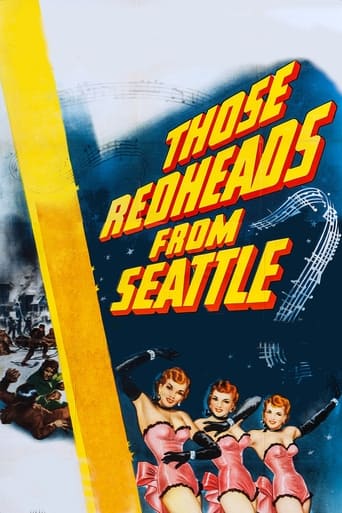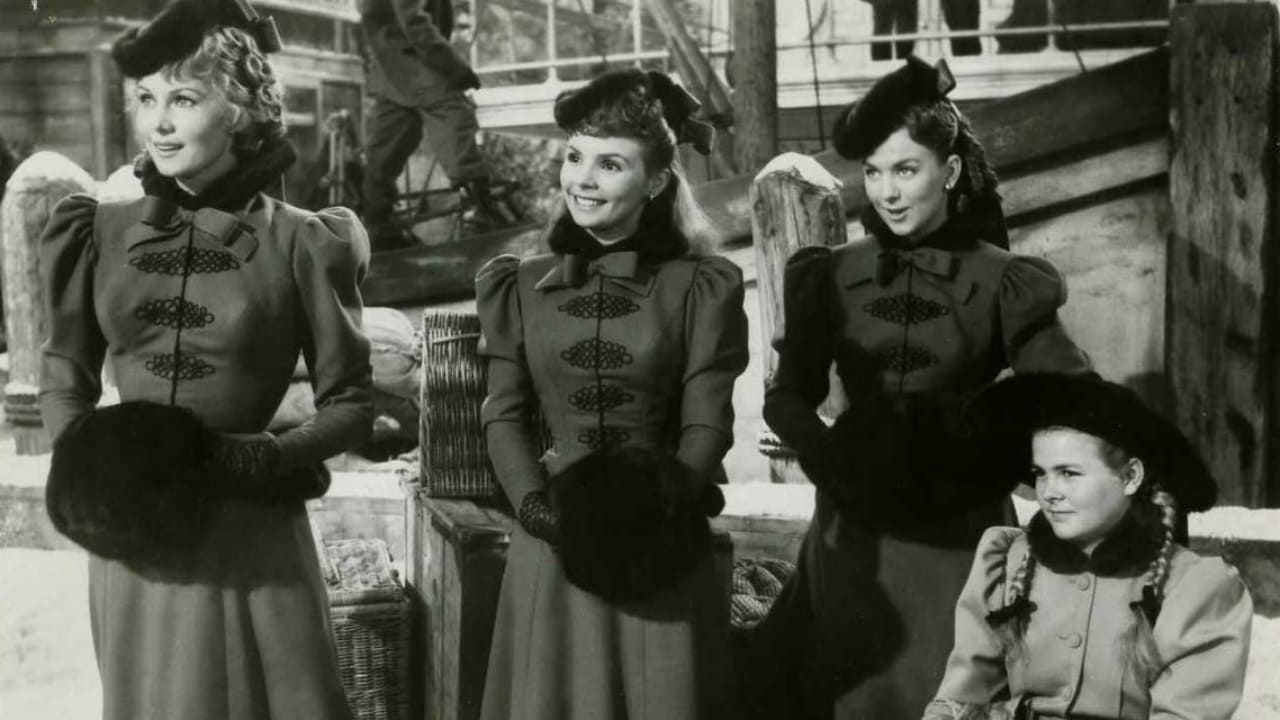weezeralfalfa
From one perspective, essentially a rip off of the prior Judy Garland-starring "The Harvey Girls", which was sited in Arizona, while this one was sited primarily in Skagway Alaska and Dawson City, Yukon Territory, although it was actually filmed at Paramount Studios. "The Harvey Girls" was based on a historical group known as the Harvey Girls, whereas the present film has no historical basis. In both films, we have a group of women, mostly marriageable straight-laced girls, who come into a frontier town, where most of the women are employed in a saloon. Pretty soon, they find themselves at odds with the co-proprietors of the saloon. In both films, the lesser proprietor takes drastic steps to encourage them to leave or tone down their antagonistic attitude. In both cases, part of this defense includes burning down part or all of the girl's work place. In both films, the leading lady has a love/hate relationship with the primary saloon proprietor, beginning mostly with hate and ending up mostly love, according to standard formula. In "The Harvey Girls", the girls run a sober restaurant, which is meant to compete with the saloon for customers. In the present film, the women eventually run the local newspaper that their father/husband died for, at the hands of the lesser saloon proprietor.Among other things, this film can be considered a musical, featuring 5 songs, we having 5 professional singers. Best remembered of these singers is Teresa Brewer, who participates in 3 of the songs. "Baby, Baby, Baby" is a solo, done on stage in Dawson. Early on, she sings and frolics around her bedroom in a fancy outfit to "Mr. Banjo Man". Later, Rhonda Fleming, and the older of The Bell Sisters singing group, join Teresa in singing and frolicking around. I will remember this scene long after I've forgotten the other scenes in this film. Teresa also took turns with Guy Mitchell in singing "I Guess it was You all the Time", on stage. Guy had a solo on stage with "Chick-a-Boom". On the boat from Seattle to Skagway, the Bell Sisters entertained the passengers singing and frolicking to "Take Back Your Gold". They sounded exactly like the Andrew Sisters, to me, in spite of having one less singer. Unfortunately, this was Teresa's only Hollywood film, and one of only two appearances for The Bell Sisters. Teresa was offered a film contract, but decided her singing career and growing family was more important. Latter, she would second guess this decision. She certainly had the all around talent and looks to be a big film star.Gene Barry played Johnny Kisco, chief saloon proprietor, while John Kellogg played Mike Yurkil, his partner and main badman of the film. Guy Mitchell played Joe, who worked for Johnny until the animosity between the Edmonds women and the saloon personnel escalated. He and Connie had formed a romantic attachment, so he decided to work for their newspaper. Agnes Moorehead played Mrs. Edmonds. Along with 3 of her 4 daughters, she had reddish or red-brown hair. Nell was a blond, as well as appearing to be younger than the others. She failed to warn the other girls of the arrival of their mother, thus one said "You can't trust a blond". Frank Wilcox played Vance Edmonds, who was only present for a short time before being executed by Yurkil. Walter Reed plays Whitey, who buys the Klondike Club from Johnny, after the latter got tired of being written up in the newspaper for doing bad things. He decided to take a boat for Fairbanks, where Yurkil was reported to have gone. He wanted to have Yurkil arrested for murder and arson. But, remember Yurkil was now in a US territory, whereas he committed these crimes in a Canadian territory. Strange that Yurkil's new partner in Fairbanks tells Johnny where Yurkil has wandered off to, after Johnny tells him why he wants to see Yurkil. Socks him on the chin to knock him out, so it looks like he made his partner tell him Yurkil's location.In summary, I see this as an interesting musical drama, with a few continuity and reality problems. It's especially valued as a unique chance to see Teresa Brewer sing, frolic, and act.
bkoganbing
Paramount's Dollar Bills, William Pine and William Thomas continued putting out films in the Fifties as they did in the Forties for Paramount's B picture unit. Only they were given a bit more bucks to play with and some bigger stars in the Fifties. For Those Redheads From Seattle they got not only color, but also 3-D making it the first musical released in 3-D.With some elements of The Harvey Girls as part of the story, Pine-Thomas could have used some better songs for the score. I noted that several different writers contributed to this one. Usually you have only one team, maybe an interpolation from another writer for the score. But in Those Redheads From Seattle it was all original material. It was like some various songwriting teams just opened the trunk for some unused material and sold it to Paramount.As one of those redheads is Rhonda Fleming who is the oldest of Agnes Moorehead's four daughters who have come to the city of Dawson in the Klondike Gold Rush you certainly have the redhead covered. Agnes is a redhead her and so are Teresa Brewer and the Bell Sisters except one of them is a blond and wonders how she got in this family. No exceptions were allowed in the Day Family in Life With Father. They got a last letter from their husband and father who ran the newspaper in Dawson and is leading a fight to clean up the bad elements in Dawson. Then one of those bad elements plugs Frank Wilcox, but not before his family has pulled up from Seattle to join him. Another of those bad elements is the owner of the largest gambling palace in Dawson Gene Barry. He's thought of as the one responsible for Wilcox no longer being among the living. He has the whole film to prove himself innocent and gain one of the daughters as a bride.Taking care of the musical chores are Guy Mitchell who sings in Barry's establishment and Teresa Brewer who would like to. Nothing here that stands out in the score. 3-D was also used by MGM for Kiss Me Kate. If you can see that in 3-D I'd recommend it before Those Redheads From Seattle.
marcslope
In 1953, while so many good musicals, and not just at MGM, are integrating their scores, plots, and production designs, this Paramount oddity is a real throwback. All the songs, by a variety of hands, are "diegetic," i.e., stage-presentation numbers that have nothing to do with plot. Which may be just as well, since the plot is such a schizophrenic affair. It's about mom Agnes Moorehead (in an uncharacteristically humorless, uninteresting performance) squiring her four daughters to the Yukon in 1898, not aware that their dad has been murdered, and their falsely blaming saloon owner Gene Barry for it. The motivations are as scattershot as the intended 3D effects; when prettiest daughter Rhonda Fleming ends up with Barry, Moorehead glows with delight, even though she's hated him for most of the movie, because, well, it's time for fadeout and we need a happy ending. Teresa Brewer, with the best songs, is spunky and appealing, and Guy Mitchell, with a lovely voice, is more effective than he was the following year in another odd Paramount musical, "Red Garters." The tone's now-somber, now-boisterous, and the western and musical motifs do not blend well.
mark.waltz
The freedom of the press is in jeopardy and it takes a hot-blooded redhead to preserve it. She is Rhonda Fleming, the daughter of a murdered newspaper man up in the Klondike. Along with her mother and three sisters (as well as a pregnant cat named President McKinley), they travel up north from Seattle into the Canadian wilds and face the horrifying truth about the corruption there. Blaming the wrong man for murder (as he owns the sinful saloon her father was writing about), Fleming prints a series of exposes and accusations when the accused (Gene Barry) tries to clear his name. Of course, the two also happen to be in love, and this leads to further complications.While nicely filmed in Technicolor, this musical lacks in humor, and has only a few rather mediocre musical numbers, generic in tone, and ultimately forgettable. One saloon number, though, is interestingly staged, utilizing only the gloved hands and tight-covered legs for the chorus girls as Teresa Brewer sings the sultry song "Baby Love Me Do". Resembling a slightly more feminine Ethel Merman, she is supposed to be the stereotypical saloon singer with proverbial heart of gold hidden by wisecracks (think Angela Lansbury in "The Harvey Girls") but her character isn't really well developed, at least personality wise.Agnes Moorehead is appropriately strict but loving as the mother of the four girls, all redheads except one. There's an exciting final where the villain is exposed but unfortunately even with different themes than most musicals, the results are rather standard.


 AD
AD


